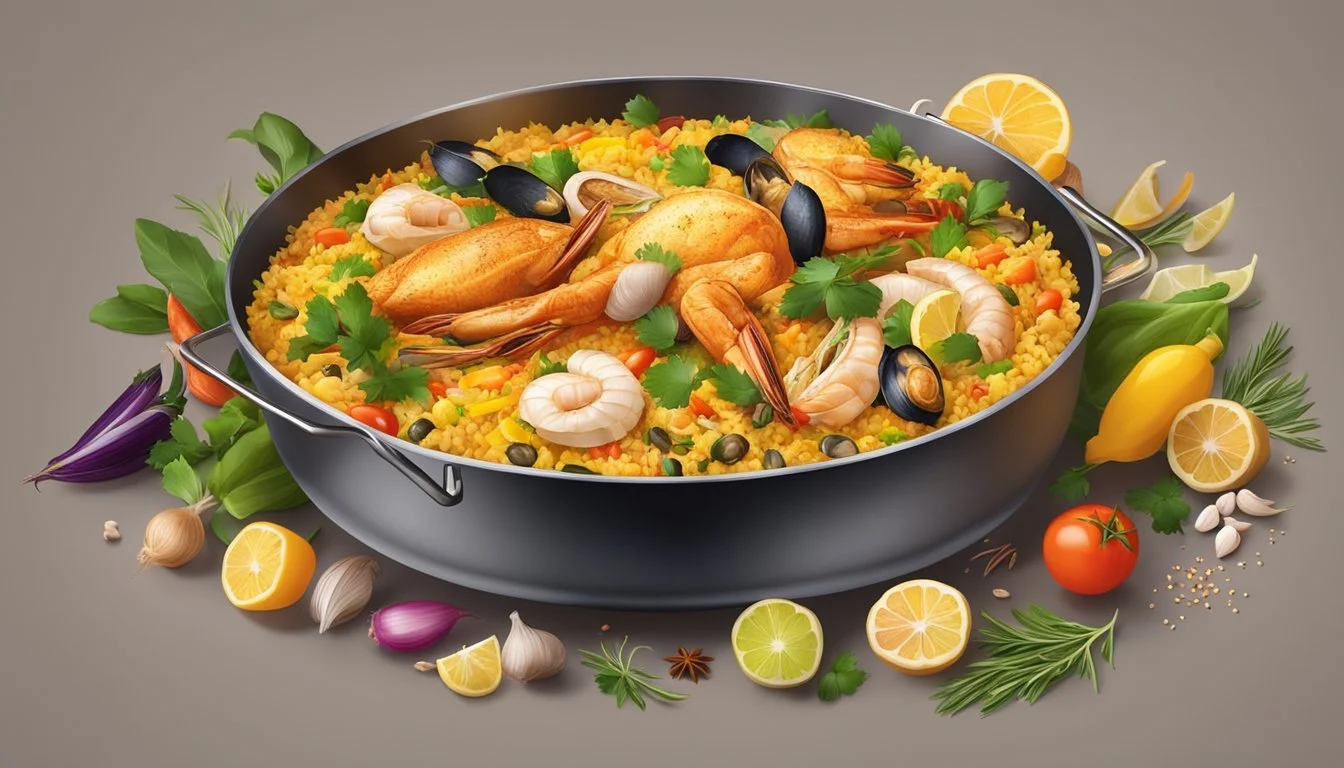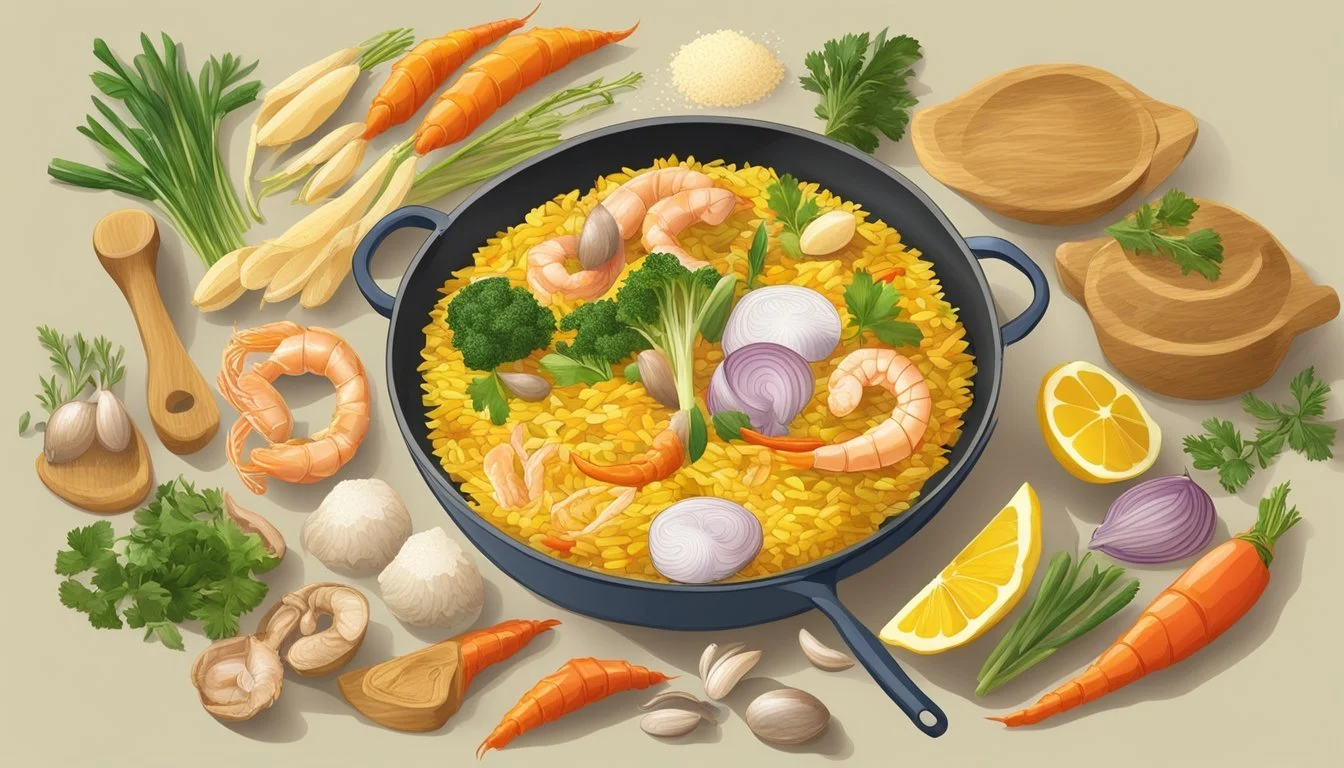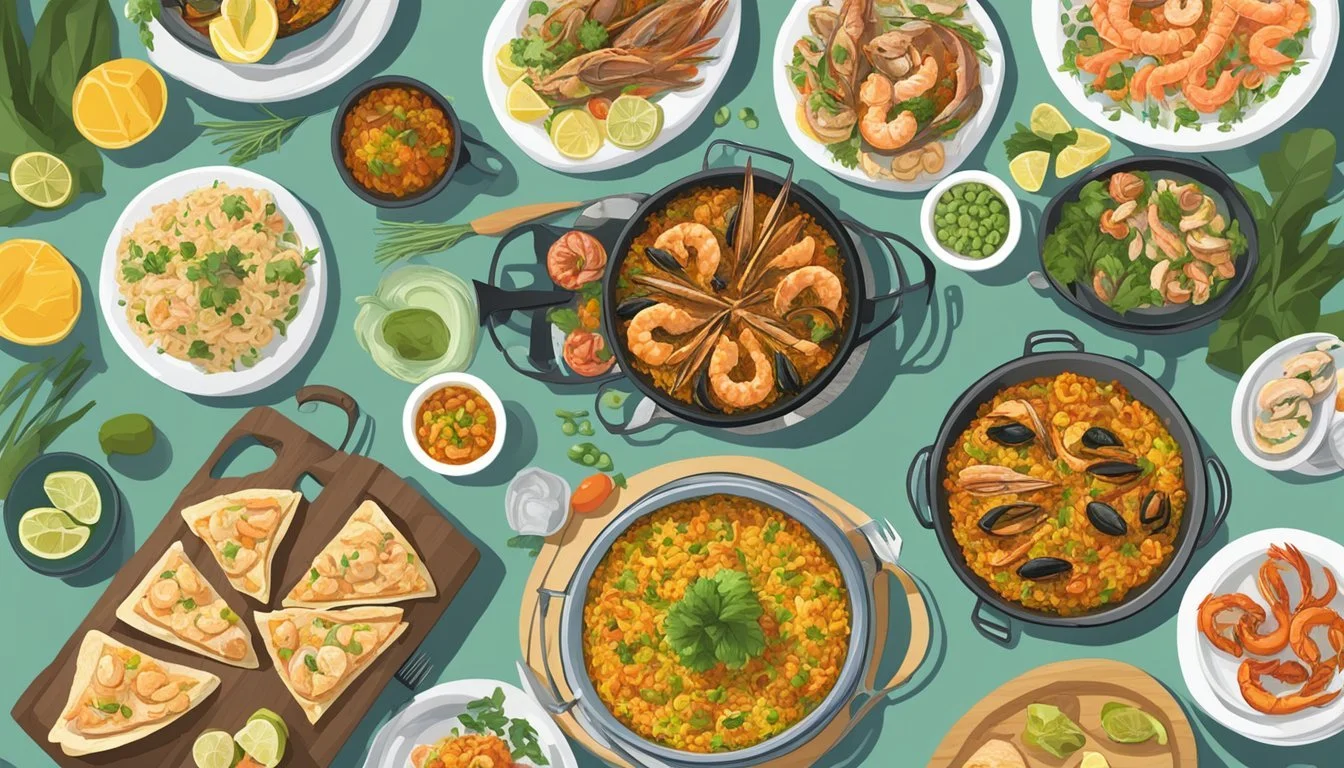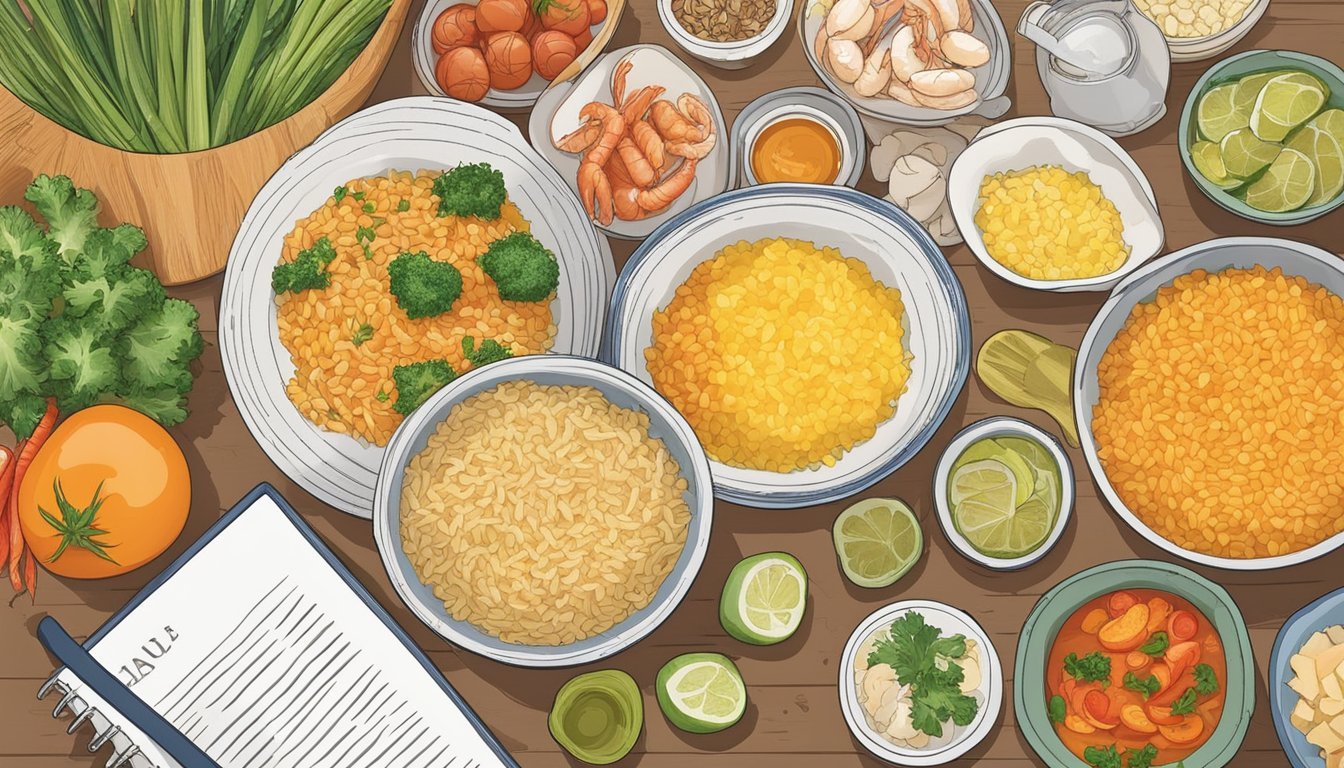Is Paella Gluten-Free?
Understanding This Traditional Spanish Dish
Paella is a beloved Spanish dish known for its rich flavors and vibrant appearance, originally hailing from the Valencia region. This traditional meal is typically made with rice, saffron, a variety of proteins, and vegetables. Due to its base ingredient of rice, which is naturally gluten-free, paella is often considered a suitable option for those with gluten sensitivities or celiac disease.
However, it's important for individuals requiring a gluten-free diet to ensure that all components of the paella are free from gluten. This includes verifying that the broth used is gluten-free and double-checking seasonings and garnishes for any gluten-containing additives. The cooking utensils and pans should also not be cross-contaminated with gluten from other foods.
To enjoy an authentic paella experience without the worry of gluten, special attention must be paid to ingredient selection and preparation methods. By choosing the right rice variety, such as Bomba or Calasparra, and using gluten-free alternatives for broth and seasoning, paella can remain a celebrated dish in the gluten-free culinary world.
What Is Paella?
Paella is a celebrated Spanish rice dish renowned for its rich flavors and diverse ingredients. It hails from the Valencia region on Spain's eastern coast, where it's seen as a cultural symbol and staple of local cuisine. The origins of paella can be traced back to the Moors who introduced rice cultivation to Spain during their occupation.
The name "paella" derives from the Old French word paelle for pan, which is a reference to the shallow, wide pan used to cook the dish. This special paella pan ensures even heat distribution, which is crucial for the development of the socarrat — the caramelized layer of rice at the bottom that is a signature element of a good paella.
Traditional paella recipes call for a variety of ingredients, typically including:
Rice: The foundation of the dish, typically a short-grain variety that absorbs flavors well.
Saffron: This precious spice gives paella its distinct yellow color and subtle flavor.
Proteins: Various forms including rabbit, snails, and chicken. Seafood (What wine goes well with seafood?) versions boast shrimp, (What wine goes well with shrimp?) squid, and mussels. (What wine goes well with mussels?)
Vegetables: Often contains green beans, peppers, and tomatoes.
Authenticity in paella is a matter of much debate, with many regions and families having their own cherished recipes. However, the essence of paella lies in the use of local, fresh ingredients, cooked slowly to create a harmonious blend of flavors. While the dish has evolved, it continues to be a signature element of Spanish gastronomy celebrated across the globe.
Understanding Gluten
Gluten refers to a group of proteins found in certain grain products, particularly wheat, barley, and rye. It's a vital component that gives bread dough its elasticity and cakes their soft texture. However, some individuals have gluten-related disorders, such as celiac disease, which is an autoimmune condition where gluten ingestion leads to damage in the small intestine.
Those with celiac disease, along with others who have a gluten sensitivity or allergy, must adhere to a gluten-free diet to prevent symptoms and health complications. This means they have to avoid foods containing wheat, barley, rye, and derivatives of these grains.
In the context of paella, a traditional Spanish rice dish, the main ingredient is typically rice, which is naturally gluten-free. However, paella can include stocks or seasonings that may contain gluten, so it is crucial to check the ingredients:
Rice: Naturally gluten-free
Stocks and Broths: May sometimes contain gluten
Sauces: Can potentially have gluten-containing additives
Seasonings: Need to be verified for gluten
People looking for gluten-free paella options can enjoy this meal with confidence by ensuring all ingredients are gluten-free. It's essential to prevent cross-contamination by using clean cookware and utensils dedicated to gluten-free cooking. This diligence allows individuals with gluten sensitivities to enjoy paella without concern.
Primary Ingredients in Traditional Paella
The foundation of traditional Paella lies in its select ingredients that are essential to create the authentic Spanish dish. Here's what goes into making a classic Paella:
Rice Varieties
The cornerstone of Paella is rice, specifically short-grain varieties like Bomba or Calasparra rice. These types of rice absorb liquid well and maintain their firmness throughout cooking.
Bomba Rice: Highly absorbent, retaining flavor from broth and spices.
Calasparra Rice: Slightly longer grain, also known for good absorption properties.
Proteins
Protein in Paella can vary widely, from an array of seafoods to different meats. Traditional Paella often features:
Chicken: Often included for its rich flavor and hearty texture.
Rabbit: A staple in Paella Valenciana for an authentic taste.
Seafood: Commonly consists of shrimp, mussels, clams, (What wine goes well with clams?) and squid.
Chorizo: A Spanish sausage that adds spice and depth of flavor.
Vegetables
While proteins are prominent, the vegetables in Paella add essential flavors and colors:
Tomatoes: Freshly diced or as a sauce, adding a tangy base flavor.
Bell Peppers: Typically red or green, they contribute to the dish's vibrancy.
Green Beans and Peas: These green vegetables provide freshness and a slight crunch.
Onion and Garlic: The aromatics that form the flavor foundation.
Spices and Aromatics
The unique taste of this Spanish dish is largely due to its combination of spices and flavorful aromatics:
Saffron Threads: The key spice that contributes color and a distinctive taste.
Paprika: Often smoked, this spice adds a subtle warmth and complexity.
Rosemary: Fresh or dried, it brings an aromatic herbal note to the dish.
Olive Oil: Used to sauté and build layers of flavor, it's the preferred cooking fat.
Each element plays a pivotal role, and the careful balance of these ingredients is what makes Paella a beloved family meal that's both healthy and satisfying.
Gluten-Free Alternatives
When preparing gluten-free paella, choosing the right rice and protein is crucial to ensure the dish remains true to its authentic flavors while adhering to dietary restrictions.
Gluten-Free Rice Options
The foundation of any paella is its rice. Traditional paella uses short-grain varieties that absorb liquid well. For a gluten-free version, brown rice and arborio rice are excellent choices.
Brown Rice: It offers a chewier texture and a nuttier flavor compared to white rice, along with added nutritional benefits like fiber.
Arborio Rice: Another naturally gluten-free option, arborio rice provides the creaminess characteristic of paella, though it typically takes longer to cook than traditional white paella rice.
One must ensure that any rice chosen is not processed in facilities that also process gluten-containing grains to avoid cross-contamination.
Gluten-Free Proteins and Vegetables
Proteins and vegetables add substance and flavor to paella.
Seafood: A popular choice for authentic paella, options like shrimp, squid, and mussels are naturally gluten-free.
Chicken: A common protein in many paella recipes, chicken should be marinated or coated with gluten-free mixtures.
Vegetables: Bell peppers, zucchini, and tomatoes are safe, gluten-free additions that enhance the paella's taste and nutritional profile.
When selecting broth, opt for a gluten-free broth, ensuring it doesn't contain any ingredients with gluten. Additionally, for those seeking a dairy-free and vegan option, plant-based proteins like beans or tofu can serve as excellent substitutes, while vegan broths maintain the dish's flavor integrity.
How to Make Gluten-Free Paella
Creating gluten-free paella hinges on the use of appropriate pans, stock, and techniques that ensure the dish remains free from gluten while still capturing the essence of this classic Spanish meal.
Choosing the Right Pan
To achieve authentic flavours, one must use a paella pan, which is wide, shallow, and ensures even heat distribution. For those who don't have a traditional paella pan, a large, flat-bottomed frying pan can suffice. The ideal pan size varies based on the number of servings, but a 12 to 15-inch diameter is sufficient for a standard family recipe.
Creating a Gluten-Free Stock
The base of any paella, including gluten-free paella, lies in the creation of a flavourful stock. Gluten-free stock can be made from scratch using vegetable broth or chicken stock, enhanced with white wine, if desired. Key seasonings include saffron, turmeric, and paprika to provide the distinct colour and complex flavours traditional to paella. It's critical to check that all broth and seasonings used are certified gluten-free to avoid contamination.
Technique and Cooking Steps
Onions: Start by sautéing onions in olive oil until softened.
Additions: Incorporate gluten-free chorizo or seafood and cook until they're well combined.
Rice: Add short-grain rice like Valencian rice and toast slightly before pouring in the gluten-free stock.
Simmering: Allow the dish to simmer without stirring, enabling the rice to absorb the stock and develop socarrat, a caramelized crust at the bottom.
Finishing Touches: In the final minutes, add lemon juice, peas, and pre-cooked proteins like shrimp or mussels. Garnish with lemon wedges for a refreshing zest.
Presentation: Serve the paella straight from the pan, with additional lemon wedges to enhance the bright, citrus flavor upon serving.
Each step requires careful attention to maintain the integrity of the gluten-free dish while aspiring to create the perfect harmony of Mediterranean flavours.
Safeguarding Against Gluten Contamination
When preparing gluten-free paella, meticulous attention is essential to prevent gluten contamination, a critical concern for individuals with celiac disease or gluten sensitivity. The process requires diligence at every stage, from ingredient selection to cooking techniques.
To begin with, ingredient integrity is paramount. All ingredients should be verified as gluten-free. This includes the rice, traditionally a gluten-free grain, and other components like broth and seasonings, which may otherwise be sources of hidden gluten.
Cookware and utensils also play a significant role. It is advisable to use cookware and utensils dedicated solely to gluten-free cooking, or thoroughly clean them if they've been used for gluten-containing foods. Here’s a simple checklist:
Utensils and Surfaces: Clean thoroughly before use.
Paella Pan: Ideally have one dedicated for gluten-free cooking.
Cutting Boards: Designate a specific board for gluten-free ingredients.
When selecting ingredients, watch out for cross-contamination in items like seafood or vegetables that could have come into contact with gluten-containing products during processing or handling.
In terms of technique, it is crucial to prevent contamination from adjacent cooking spaces. Even airborne flour from other dishes could contaminate the paella, so it's recommended to prepare the dish in a controlled and clean environment.
Lastly, communication with any suppliers or dining companions about the importance of gluten-free integrity can help manage the risk of accidental contamination. Careful labeling and storage of gluten-free ingredients can assist in maintaining a safe cooking environment.
By employing these stringent measures, chefs and home cooks can be confident in their ability to provide a truly gluten-free paella, offering peace of mind and enjoyment to those with dietary restrictions.
Common Questions About Gluten-Free Paella
Navigating the realm of gluten-free cuisine can be perplexing, especially with dishes as culturally rich as paella. Addressing common concerns, this section aims to clarify the intricacies of preparing authentic gluten-free paella.
Can You Use Any Rice?
No, not all types of rice are suitable for making paella. The traditional choice is a starchy, short to medium-grain Spanish rice, such as Bomba or Calasparra, as they are excellent at absorbing flavors without becoming mushy. These varieties also help in forming the 'socarrat', a prized crispy layer at the bottom of the pan which is characteristic of a good paella.
Is Seafood Gluten-Free?
Seafood on its own is naturally gluten-free and a staple in seafood paella, featuring fish, shrimp, squid, and mussels. However, when preparing a gluten-free paella, it is crucial to ensure that the seafood is not marinated or prepped with ingredients containing gluten. Cross-contamination is another concern, so one should make sure all seafood is processed on clean surfaces free from any gluten residues.
Tips for Hosting a Gluten-Free Dinner
When hosting a gluten-free dinner featuring paella, here are some best practices to ensure guest safety and meal enjoyment:
Use gluten-free broth instead of ones that might contain gluten as a thickening agent.
Opt for gluten-free chorizo or chicken sausage; traditional versions may contain gluten.
Clearly label all dishes and ingredients to avoid any confusion.
Cook in a clean environment to prevent cross-contamination with gluten-containing foods.
Educate yourself and your guests on the ingredients to raise awareness of gluten-related health concerns.
With careful ingredient selection and mindful preparation, one can master the art of creating a sumptuous gluten-free paella that brings a taste of Spain’s culinary heritage to the gluten-conscious table.
The Cultural Significance of Paella
Paella, a vibrant Spanish rice dish, has substantial cultural significance within Spain, especially in its place of origin, the Valencia region. It embodies the essence of Spanish cuisine and symbolizes the rich agricultural history of this area. Historically, the Moors are credited for introducing rice to Spain, thus laying the foundation for dishes such as paella.
The name 'paella' itself originates from the Old French word "paelle" for pan, which is a reference to the wide, shallow pan used to cook the dish. The pan itself is essential to creating an authentic paella, as it allows for the rice to be spread thinly and cook evenly.
Valencian paella, or paella valenciana, sets the standard for the genuine article and traditionally includes white rice, green vegetables, meat (rabbit, chicken, or duck), sometimes snails, beans, and seasoning such as saffron and rosemary. Another popular variety is paella mixta, which typically combines meat with seafood, but this variation is often met with disapproval from purists for diverging from the authentic version.
It's not merely a dish; it's a reflection of Spanish identity and tradition, often associated with family gatherings and festivities. The process of cooking and sharing paella is a social activity that speaks to the union and communal spirit of Spain.
In recent years, paella has gained recognition beyond being a culinary delight—it is cherished as an artistic expression of Spanish culture. It was given protected status, highlighting its centrality to Spain's cultural heritage and the importance of preserving traditional methods of preparation.
Regional Variations of Paella
Paella, a quintessential Spanish rice dish, has multiple regional variations that celebrate local flavors and cultural traditions. Originating from the Valencia region, Paella Valenciana is often regarded as the most authentic form of the dish. It traditionally includes white rice, green beans, meat (such as rabbit and chicken), snails, and seasonings like saffron and rosemary.
Moving away from Valencia, variations adapt to incorporate locally available ingredients. Coastal regions, for example, often serve Seafood Paella, which focuses on fresh ocean fare such as fish, shrimp, squid, and mussels. This marine variety omits meats and snails, providing a lighter option that emphasizes the bounties of Spain's coastal waters.
Paella Mixta, a mixed variety, combines meat with seafood, bridging the components of Paella Valenciana and its seafood counterpart. It typically presents a hearty family meal that features a diverse range of flavors, satisfying a variety of palates.
In contrast, those preferring plant-based options can enjoy Vegetarian Paella, teeming with a colorful assortment of vegetables like bell peppers, zucchini, and tomatoes. This variation stays true to the dish's humble beginnings as a farmer's meal while catering to modern dietary preferences.
Each regional variation maintains the foundational elements of paella—a rice base and the use of a wide, shallow pan—but they personify the gastronomic diversity within Spanish cuisine. While regional paellas can differ significantly from the original Valencian recipe, they are all connected through their celebration of family, fellowship, and the art of cooking over an open fire.
Dining Etiquette and Presentation
When serving paella, especially when striving for an authentic experience reminiscent of the Valencia region, presentation plays an essential role. The dish is traditionally presented in the very pan it is cooked in, which not only imparts a rustic charm but also retains the heat of the meal.
The table etiquette for a paella meal is often communal and informal, reflecting the family-centric culture of Spain. It is customary for diners to eat directly from the pan, which fosters a shared dining experience. This is especially appropriate for family gatherings, where the act of sharing food is a sign of unity.
In terms of garnishing, a few simple additions can significantly enhance the appearance and flavor of the dish:
Lemon Wedges: They are commonly placed around the edges of the paella pan. Diners can squeeze lemon juice over their portion to add a fresh, zesty flavor that complements the savory notes of the dish.
Parsley: A sprinkling of finely chopped parsley adds a vibrant touch of green and a mild, herby freshness.
| Garnish | Purpose |
|--------------|-------------------------|
| Lemon Wedges | Add zest and freshness |
| Parsley | Enhance visual appeal |Presentation details such as arranging seafood toppings attractively and ensuring the coveted crispy layer of rice (known as 'socarrat') is visible, are elements that can make a paella dish visually appealing and texturally satisfying. These nuances, coupled with proper dining etiquette, contribute to the overall enjoyment and authenticity of the paella experience.
Storing and Reheating Leftovers
When dealing with leftovers of gluten-free paella, proper storage is crucial to maintain its taste and quality. They should promptly store it in the refrigerator within two hours of cooking to ensure food safety. Gluten-free paella can be safely refrigerated in an airtight container for up to three days. To prevent moisture loss, one might drizzle a small amount of olive oil over the paella before sealing the container, as olive oil can help retain the dish's robust flavors and contribute to a health-conscious diet.
For reheating, they have several methods to choose from:
Microwave Method:
Place the paella in a microwave-safe container.
Lightly coat with olive oil to refresh the flavors.
Cover with a lid or a damp paper towel to retain moisture.
Reheat on high for 1-2 minutes, stirring every 30 seconds.
Stovetop Method:
Pour 2-3 tablespoons of water or broth into a pan.
Add the paella, breaking up any clumps.
Cover with a lid and reheat on medium for 4-5 minutes, stirring occasionally.
Oven Method:
Preheat the oven to 350℉.
Spread the paella in an oven-safe dish.
Add a few tablespoons of water to keep it moist.
Bake for about 20 minutes, stirring occasionally.
Reheating is best done at moderate temperatures to prevent drying out, and by adding moisture, be it water, broth, or a dash of olive oil, to keep the paella moist and flavorful while maintaining its gluten-free integrity.
Economical Tips for Making Paella on a Budget
When preparing paella on a budget, the main goal is to achieve rich flavors without overspending. Choosing economical ingredients and employing cost-saving techniques can lead to a deliciously affordable meal.
Firstly, rice, the foundation of paella, should be a short-grain variety such as bomba or calasparra, but for those on a budget, any short-grain rice can suffice as it absorbs flavors well. To save further, buy rice in bulk and store properly.
Regarding seafood, while traditional paella often features an array of expensive seafood, one can opt for less costly options like frozen shrimp or squid. Mussels and clams offer an affordable way to enhance the dish and a small amount can go a long way in adding both flavor and presentation.
For meat, consider using chicken thighs or drumsticks as they are cheaper cuts but remain flavorful. For authenticity, chorizo is a popular choice, yet even a small quantity can impart a strong taste.
When it comes to spices, saffron is the hallmark of paella but can be pricey. As an alternative, turmeric can provide a similar color and a hint of flavor at a fraction of the cost. Paprika and garlic are also essential but inexpensive spices that should be used.
Utilize seasonal vegetables to minimize costs. Peppers, tomatoes, and onions are staples in paella that give the dish its signature look and taste. Frozen peas are a thrifty addition that bring a pop of color and sweetness.
Finally, the stock is crucial for moistening and flavoring the rice. While homemade is ideal, a quality store-bought stock can be cost-effective and time-saving.
Ingredient Budget-Friendly Option Seafood Frozen shrimp, mussels Meat Chicken thighs, chorizo Spices Turmeric, paprika Vegetables Seasonal picks, frozen peas Rice Bulk short-grain Stock Store-bought
By thoughtfully selecting ingredients and making smart preparations, one can create a richly flavored paella that is both satisfying and budget-conscious.













